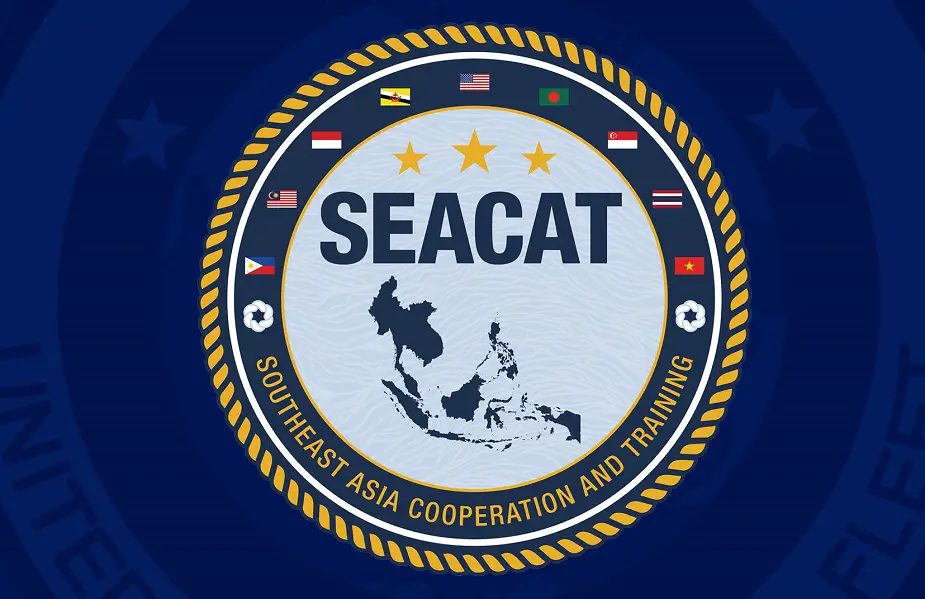Maritime forces from 21 Indo-Pacific partner nations including the U.S. Navy, U.S interagencies, and international organizations began the 20th iteration of Southeast Asia Cooperation and Training (SEACAT) in Singapore and virtually, Aug. 10.
Follow Navy Recognition on Google News at this link

The exercise scenarios are designed to encourage countries to use maritime forces to enhance understanding of the operational environment, build capacity for humanitarian support missions, and uphold international laws and norms (Picture source: US Navy)
SEACAT is a multilateral exercise designed to enhance cooperation among Southeast Asian countries and provide mutual support and a common goal to address crises, contingencies, and illegal activities in the maritime domain using standardized tactics, techniques, and procedures.
“In this region, the strength of our partnerships matter and our ability and willingness to work together is paramount,” said Vice Adm. Karl Thomas, commander, U.S. 7th Fleet. “This year’s SEACAT aims to enhance our interoperability as we address our shared maritime security concerns and preserve rules-based international order.”
The exercise scenarios are designed to encourage countries to use maritime forces to enhance understanding of the operational environment, build capacity for humanitarian support missions, and uphold international laws and norms.
SEACAT promotes shared commitments to maritime partnerships, security, and stability in Southeast Asia. Signifying the largest iteration to date, 21 nations will participate, including Australia, Bangladesh, Brunei, Canada, France, Germany, India, Indonesia, Japan, Malaysia, Maldives, New Zealand, Philippines, South Korea, Singapore, Sri Lanka, Thailand, Timor-Leste, United Kingdom, United States, and Vietnam.
A maritime operations center in the International Fusion Center in Singapore will serve as a centralized hub for crisis coordination and information sharing in the tracking of contracted merchant vessels simulating suspicious vessels of interests throughout Southeast Asian seas. Countries will work with all available maritime domain awareness (MDA) tools to provide cueing and contact information to another country’s operations center and maritime patrol reconnaissance aircraft or surface assets with the stated goal of enforcing international rules, laws, and norms.
“The scenarios are designed to encourage countries to work together though maritime domain awareness assets to better understand operations and adherence to international norms,” said Capt. Tom Ogden, commander, Destroyer Squadron (DESRON) 7. “Practicing multilateral, multi-platform intercepts help our Southeast Asian partners prepare for possible real-world engagements in the future.”
In all, SEACAT includes 10 ships and more than 400 personnel. U.S. Navy participants include USS Tulsa (LCS 16), staff of DESRON 7, P-8A Poseidon aircraft assigned to Task Force 72, and personnel from Task Forces 73, 76, U.S. 7th Fleet, and U.S. Pacific Fleet.
This year incorporates U.S interagencies of Joint Interagency Task Force West (JIATF-West), U.S Indo-Pacific Command’s executive agent for counter-narcotics; and Defense Threat Reduction Agency (DTRA), Department of Defense’s official combat support agency for countering weapons of mass destruction. Their role is aimed at providing greater understanding of the operational environment and adherence to established rules, laws, and norms across the joint environment.
For the first time, international organizations and non-governmental organizations play a role in SEACAT by providing greater understanding of the operational environment through scenario injects designed to simulate real world situations that enhance understanding and adherence to accepted rules, laws, and norms. Participants include United Nations Office of Drugs and Crime (UNODC), EU Critical Maritime Route Wider Indian Ocean (CRIMARIO), and International Committee of the Red Cross (ICRC). Application of Women, Peace, and Security (WPS) principles ensure respect for principles that align with accepted standards for human rights and fair treatment of women.
As the U.S. Navy’s destroyer squadron forward-deployed in Southeast Asia, DESRON 7 serves as the primary tactical and operational commander of littoral combat ships rotationally deployed to Singapore, functions as Expeditionary Strike Group 7’s Sea Combat Commander, and builds partnerships through training exercises and military-to-military engagements.
Under Commander, U.S. Pacific Fleet, 7th Fleet is the U.S. Navy's largest forward-deployed numbered fleet, and routinely interacts and operates with 35 maritime nations in preserving a free and open Indo-Pacific region.



